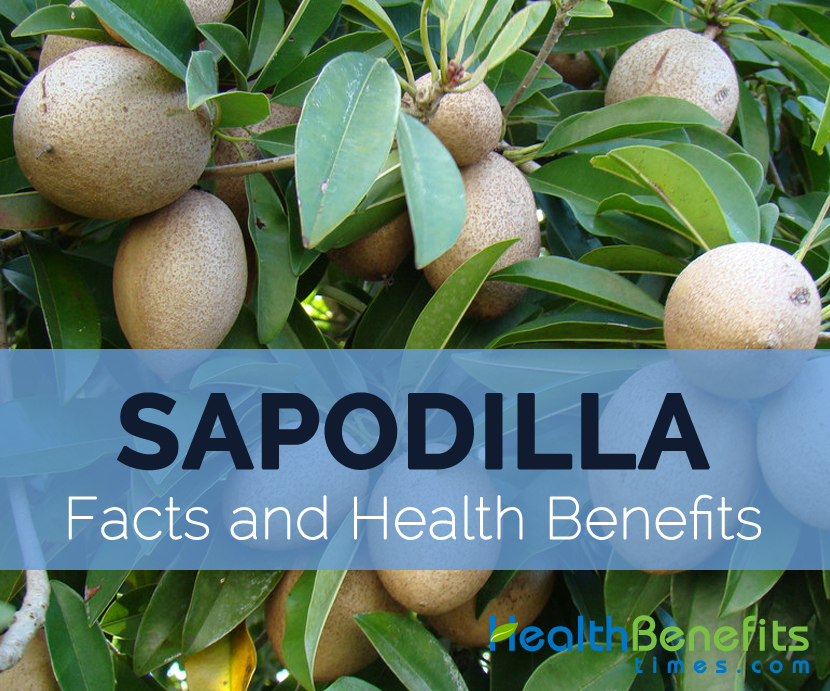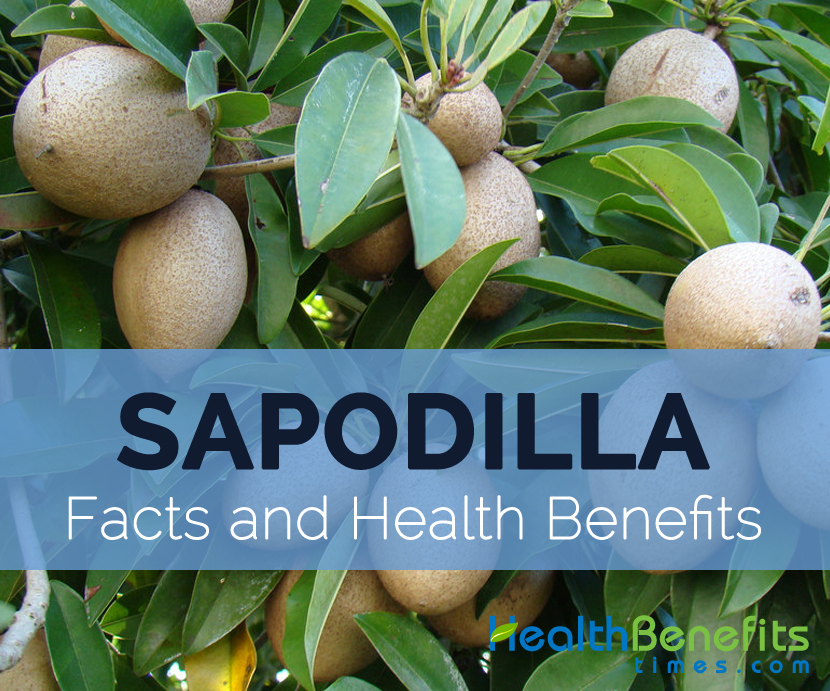| Sapodilla Quick Facts | |
|---|---|
| Name: | Sapodilla |
| Scientific Name: | Manilkara zapota |
| Origin | Southern Mexico, Central America and the Caribbean. Also cultivated in Thailand, India, Cambodia, Malaysia, Bangladesh and Indonesia . |
| Colors | Pale yellow - brown color with grainy texture |
| Shapes | Ovoid or ellipsoid, Diameter: 2-4 inches (5-10 cm) |
| Flesh colors | Brownish |
| Taste | Sweet |
| Calories | 200 Kcal./cup |
| Major nutrients | Vitamin C (39.33%) Carbohydrate (37.00%) Dietary Fiber (33.68%) Iron (24.13%) Copper (23.00%) |
| Health benefits | Relieves stress, Prevents cold, Prevents anemia, Reduce arthritis, Heals wound |
| More facts about Sapodilla | |
Sapodilla is also known by the various vernacular/common names: Brazil: Sapoti; German: Breiapfel, Sapotillbaum; Hindu: Chikoo, Korean: Kkom Na Mu; Pakistan: Cheeku etc. Sapodilla is also called Bully Tree, Chicle, Chico Sapote, Chiku, Marmalade Plum, Naseberry, Sapodilla, Sapote and Sapodilla Plum.
Plant
The Sapodilla is an evergreen, long-lived, erect and lactiferous tree which reaches upto 100 ft. high with an alternately arranged leaves. The leaves are oblong-lanceolate to ovate-elliptic, medium green, glossy, 3 to 4-1/2 inches in length and 1 to 1-1/2 inches in width. The flowers are small, white and bell-shaped with the diameter 3/8 inch (9.5 mm). The tree yields the flowers throughout the year. Each branchlet is arranged horizontally or drooping. The rough dark brown bark possesses a white and gummy sap. Sapodilla grows on subtropical and tropical climates. It prefers well-drained and light soils.
Fruit
Sapodilla is the fruit of the plant family Sapotaceae which is generally available from May-September. Initially brown and somewhat sweet in taste, Sapodilla is pale yellow-brown color with grainy texture and shaped like ovoid or ellipsoid. Their brownish flesh has 3 to 12 small, smooth, flattened, black seeds of ¾ inch in length at the center. The fruit come in variety of sizes ranging from 3/8-inch (9.5 mm) in diameter and weighs about 150 gm. Sapodilla is thin skinned and possess sweet, pleasant flavor.
Nutritional Value
The nutritional value of Sapodilla in 241 grams of the fruit are as: Calories (200 Kcal), Dietary Fiber (12.8 g), Fat (2.65 g), Protein (1.06 g), Carbohydrate (48.1 g), Calcium (51 mg), Water (187.98 g), Magnesium ( 29 mg), Iron (1.93 mg), Potassium ( 465 mg), Phosphorous (29 mg), Pantothenic acid (0.607 mg), Vitamin C (35.4 mg), Folate (34 µg), Niacin (0.482 mg) and Vitamin A (7 µg).
Health Benefits of Sapodilla
Sapodilla possesses anti-inflammatory properties. It contains dietary fiber in very good amount. The people of India used it for anti-bacterial and anti-viral properties. It maintains the overall health as it is loaded with various nutrients. Sapodilla is rich in calories. Along with the fruit, other parts are also used to the colds and cough because it contains antidiarrheal, diuretic, antihyperglycemic, antibiotic and hypercholesteraemic effects.
- Relieves stress
The study analysis shows that Vitamin C helps the weakened immune system which is caused due to stress. The stress has become the common health problems which could be relieved with the adequate intake of Vitamin C that improves the overall health. Vitamin C could be found in Sapodilla by 39.33%.
- Prevents cold
The presence of Vitamin C enhances the immune system to counteract the colds and viruses. 1000 mg of Vitamin C helps to prevent the cold. The evidence shows that Sapodilla which is rich in Vitamin C helps to prevent the chances of lung infections and pneumonia.
- Helps in digestion
Fiber is essential to improve the digestion. Insoluble fiber assists to pass the stool and bulk through the body which forbids the health conditions such as colon cancer, diverticulitis and inflammatory bowel.
- Helps to lose weight
The fiber rich foods help to lessen the food cravings. It reduces the blood glucose spike that results in less carbohydrate cravings and less storage of fats. It assists to eliminate bowels that results in weight loss. One should add the high protein foods to the diet for losing weight.
- Prevents anemia
Anemia is caused due to the deficiency in iron. The body won’t be able to produce hemoglobin and transport oxygen due to inadequate presence of iron. The patients of anemia experiences the symptoms such as poor mental function, lack of energy and apathy. Anemia is mostly seen in children and menopausal women so they should consume the foods rich in iron.
- Proper function of brain
The brain requires oxygen for efficient function. The iron assists to deliver the oxygen to the brain and eliminates poor memory and apathy. The deficiency in iron results in restless, irritable and inattentive.
The study has shown that copper assist in galactose and dopamine which are the neurotransmitters essential to maintain energy, mood, outlook and focus.
- Reduce arthritis
Copper possess anti-inflammatory properties which eliminates stiffness and pain related to arthritis. It helps to strengthen muscles, lower the joint pain and repairs the connective tissue. The arthritis patients wear copper bands or bracelets with a belief that the copper can reduce the painful symptoms.
- Healthy skeletal structure
Copper is essential for the growth of bones, connective tissue and muscles. The deficiency of copper increases the chances of osteoporosis, muscle weakness, low strength, breakage, weak joints etc. The studies show that the intake of copper with manganese, zinc, calcium slows the loss of bone in older women.
- Heals wound
The studies show that Vitamin B5 speeds up the healing process of cuts and wound and also treats the skin reactions from radiation therapy. It also slows down the aging process such as dark spots and wrinkles. The recent studies show that Vitamin B5 accelerates the healing process by improving the multiplication of cells.
- Assist nervous system
Potassium is vital for the cellular function, nerve impulses and electrical signals that the function of brain depends on. Potassium deficiency leads to poor concentration, fatigue, trouble in remembering and learning and change in mood.
https://www.youtube.com/watch?v=DqXDXK-AjLg
Traditional uses
The decoction of this fruit is useful to treat diarrhea. The infusion of the young fruits and flowers helps to soothe the pulmonary ailments. The seed of this fruit contains quercetin and saponins which are used as aperient, febrifuge, diuretic and tonic. The compressed seeds are used to eradicate the bladder and kidney stones. The paste of the seeds is applied in case of the bites and stings from venomous animals. The decoction of old, yellowed leaves is effective for colds, coughs and diarrhea. The daily intake of decoction made from the Sechium edule leaves and Sapodilla helps to reduce the blood pressure. In the tropics, the latex is used for tooth cavities. The decoction of bark is useful to cure diarrhea, dysentery and paludism. The flowers are used in Indonesia as an ingredient of a powder which is rubbed on the woman’s body after childbirth. The fever and diarrhea is treated in Cambodia with the bark as it possesses tannin.
How to Eat
Sapodilla is consumed raw by scooping the flesh out or made jam or sherbet. It is also added to the pancakes and cakes. It is also found in the form of custard, juice, ice creams or milkshakes.
Precautions
The intake of unripe Sapodilla causes the irritation in throat, breathing problems and mouth ulcer. Raw Sapodilla possesses bitter taste due to the high amount of latex and tannins. The consumption of Sapodilla in huge amount assist to increase weight as it is high in calories. The excessive amount of Sapodilla causes the discomfort and pain in the abdomen. As the seeds are high in toxic, it should be avoided to use as a medication.
Comments
comments

